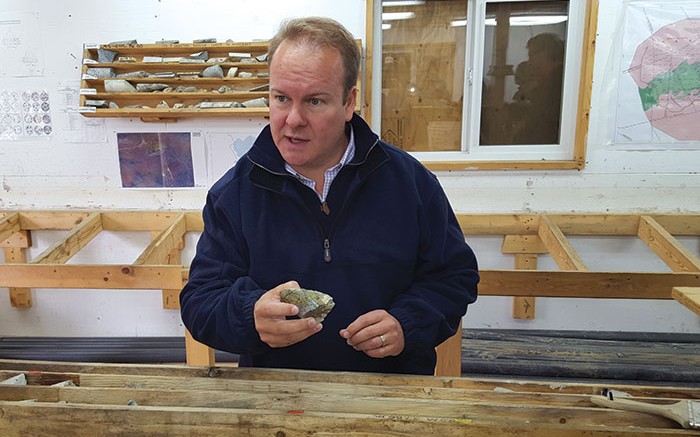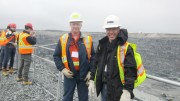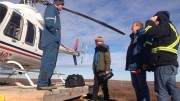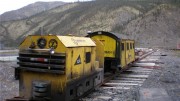WHITEHORSE, YUKON — It may not be the best time to develop a bulk-tonnage mining operation, but Western Copper and Gold (TSX: WRN; NYSE-MKT: WRN) is sure that the Casino copper-gold deposit will be one of the first projects off the production line when markets emerge from their current financial paralysis. And it’s pretty hard to argue, considering the asset is a rare beast due to its potential as a long-life, open-pit copper-gold porphyry mine in a stable Canadian jurisdiction.
Helicopters kick up clouds of dust at the well-established Casino base camp, 150 km northwest of Carmacks in west-central Yukon, as environmental crews take flight to complete late-stage baseline work and advance the project through the territory’s regulatory process. It’s late August and Western Copper is running a pretty lean operation since it is well beyond the exploration and engineering stage. Casino is practically shovel-ready, outside of its mining permits.
Casino’s claims — which cover over 130 sq. km of well-rounded ridges and hills dotted with sparse black spruce and paper birch trees — have a history that dates back to silver-lead exploration in the early 1900s.
The game-changing porphyry discovery didn’t come until the late 1960s, however, with soil geochemistry results from a trenching program.
When Western Copper acquired a 100% stake in Casino in 2006, the main deposit already had over 80,000 metres of drilling data, and the company proceeded to add another 31,000 metres between 2008 and 2012.
A feasibility study followed in 2013, and it remains the most up-to-date technical document filed at Casino.
Due to Western Copper’s confidence in its copper-gold-molybdenum resource and mine planning, the company is fully committed to watching the markets, shopping for financing and advancing the project through the Yukon Environmental and Socio-economic Assessment Board’s (YESAB) review process.
“I like bringing people to site because it illustrates just how relatively simple our mine plan is going to be and that there are not a lot of earthworks that need to be done to get things up and running,” president and chief operating officer Paul West-Sells says while standing in front of long rows of carefully stacked core boxes.
“What we’ll look at here is extremely conventional flotation technologies that are used at numerous copper operations in B.C. When we inherited the project it was, for the most part, drilled off. We’re dedicated to building this large, important mine in the Yukon,” he adds.
Western Copper’s plan envisions a conventional open-pit mine, concentrator complex and heap-leach operation. The company will focus on Casino’s oxide cap, which would be heap-leached at 25,000 tonnes per day to produce gold and silver doré. The main sulphide deposit will be processed via the 120,000-tonne-per-day concentrator to produce copper-gold-silver and molybdenum concentrates.
The study is based on proven and probable millable reserves of 965 million tonnes grading 0.2% copper, 0.24 gram gold per tonne, 0.023% moly and 1.74 grams silver per tonne. Total contained metal in the combined millable and heap-leach reserve is equal to 4.5 billion lb. copper, 8.9 million oz. gold, 483 million lb. molybdenum and 65 million oz. silver.
“It’s important to pay attention to the weathering profile of the deposit because it influences what we’re doing with the metallurgy. The cap of the deposit on top of the hill in front of us contains the gold-enriched oxide zone, created by a lack of glaciation that has essentially no pre-stripping at all,” West-Sells points out in Western Copper’s core shack.
“So that gets mined off and put on a heap-leach pad. Beneath there’s a thin supergene oxide zone we won’t process. Then you get into the supergene sulphides and the hypogene, which are the rich copper minerals that also contain gold. Those will go through our flotation process, and offer most of the value for the project,” he continues.
The copper grades are indeed low, but gold credits help make up the difference. Western Copper’s reserve grade sits at 0.5% copper equivalent.
And that’s why Casino appears economic at less than US$3 per lb. copper. Assuming a red metal price of US$2.35 per lb., the proposed mine features a US$1.3-billion net present value at an 8% discount rate and a 17.5% internal rate of return. The operation would annually produce 171 million lb. copper, 266,000 oz. gold, 1.4 million oz. silver and 15.5 million lb. moly.
The next stage of our journey is a 15-minute helicopter flyover of the Casino site atop the Dawson Range. West-Sells points out the location of the flotation tanks where the cafeteria stands, and where Western Copper intends to place its flooded tailings facility. The company will likely move concentrates to port in Skagway, Alaska.
Planned infrastructure include a 132 km unpaved road from the end of the Freegold Road, which runs 70 km northwest of Carmacks; and a stand-alone liquefied natural gas (LNG) station that would power the off-the-grid operation.
“We put a lot of thought into our power supply situation, and around five years ago we determined that LNG was the way to go. When we first started talking about it, people were skeptical, but we consulted with Yukon Energy Corp. about the possibility, and they have moved forward with it,” West-Sells says. “You can see the result with the recently commissioned LNG plant in Whitehorse. It adds up and makes a lot of sense, because it is a cheap and relatively clean way to generate electricity in the North.”
The 150-megawatt power station would require storage tanks to keep seven days’ worth of fuel on-site, with the Casino operation needing 10 trucks of LNG daily.
The next steps for Western Copper involve moving into YESAB’s assessment stage.
Advancing through a multi-year regulatory process was viewed as a down period for companies during previous commodity booms due to a lack of exciting news and potential share catalysts.
But given that copper prices recently dropped below US$2 per lb., however, it appears that Western Copper couldn’t be in a better position to weather the commodity downturn.
The company was sitting on working capital of $10 million at the end of 2015, and can adjust its burn rate and corporate spend throughout permitting to keep its cash position.
Meanwhile, management will search for prospective partners to help fund the US$2.4-billion project, and hope for a higher share price to limit dilution on any equity financings.
“Our view has always been more focused on the longer term. We know that the world will continue to need copper, and there will be a preference for long-life mines located in strong, low-risk jurisdictions … we’re going through a down market, but projects like Casino are where people make money in our business,” West-Sells says.
“Our mine would be one of the lower-cost producers when it comes to development-stage projects globally. These are important assets, but we have to remember that building a mine of this size takes time and requires patience. In terms of the macro-mining environment … there aren’t that many projects of this type in the development pipeline, since most companies are in cost-savings mode and foregoing expansion.”
Over its mine life, Casino could conceivably contribute an estimated $9.7 billion to Canada’s gross domestic product, create 51,000 full-time equivalent positions and pay out $2.5 billion in wages and salaries. During each of its 22 years of operation, the mine could add $274 million to the Yukon’s economy.
Western Copper shares have traded within a 52-week range of 30¢ to 75¢, and closed at 33¢ per shar
e at press time. The company has 94.2 million shares outstanding for a $31.1-million market capitalization.





Be the first to comment on "Site visit: Western Copper sees Casino as an economic driver in the Yukon"